“Default a little more on the art side, but never loose sight of the science” might be good advice for radio programming in PPM radio markets and beyond.
Program directors and radio researchers shared their best practices for PPM radio programming at the Worldwide Radio Summit 2013 conference in sunny Hollywood. It turns out that the founding fathers of CHR have set standards that might be more relevant now than ever before. Find out how some of the best PDs in the business “program the hell out of it”.
“Making fans, keeping fans, and keeping them happy”
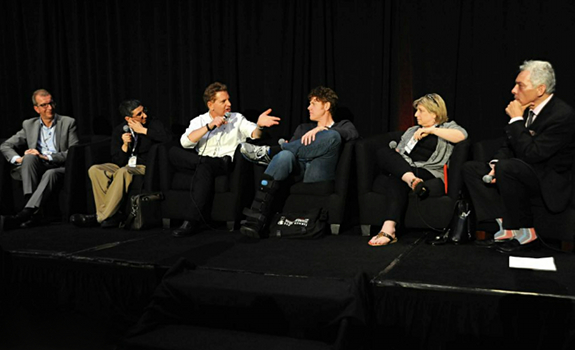
97.1 AMP RADIO Los Angeles program director John Michael (4th from the left) thinks that great radio is about building strong relationships through authentic personalities who give a station soul (photo: KC Morse)
Focus on multi-platform entertainment
“We’re trying to control something we can’t control”, says Mike McVay, former radio consultant and current SVP of Programming for Cumulus Media during his introduction of the session. Program directors are facing a challenge: they have no influence over who gets a Portable People Meter, yet satisfy survey participants as well as ‘normal’ listeners. Emmis Communications group program director and Rhythmic CHR Power 106 LA PD Jimmy Steal thinks that “at a certain point, methodology is almost irrelevant. If you focus on just making the most relevant, topical, funny, entertaining stuff; come out of your box and live across all your platforms, it certainly positions you for a better chance of success.”
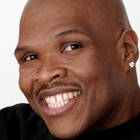 Build relationships through personalities
Build relationships through personalities
What are the secrets of great radio programming that all great stations have in common? “I’m a big believer in personality radio”, Steal says about radio’s ability to “be connected to an audience that not only consumes our brand, but has a relationship with our brand. It looks to us to find out what is cool; what is new; what is hip.” He doesn’t believe that radio’s gatekeeper function has been deluded by an abundance of other choices.
Create following through soul
After programming CBS Radio‘s legendary Modern Rock station KROQ (‘K-Rock’) in Los Angeles, John Michael was appointed as PD for the company’s Top 40 format 97.1 AMP RADIO in that city. In his opinion, radio is all about “soul”, and he has the impression that their jocks all sound authentic on the air. “We have a relationship with our listeners, based on authenticity, credibility and delivering.” Although they are aware of PPM, they mainly focus on “making fans, keeping fans, and keeping them happy. You want people to feel a certain way about your radio station, and be a part of their lives. The rest will take care of itself.”
“Every PD has an artist in him”

Program directors who can turn audience research insights into successful radio programming are like painters because they turn science into art, says RCS and Media Monitors president Philippe Generali (photo: KC Morse)
Win in several dayparts
“The great storytellers; the great relators; the people who actually understand their audience and come in from their perspective instead of the ego, are the people who really make a difference”, says research veteran Carolyn Gilbert of nuvoodoo. Her colleague Anthony Acampora of RadioCrunch sees the same, based on his comparison of PPM data in relation to station output. His advice for program directors is to not only focus on the morning show anymore. “It is perceptual that you have to win in mornings, but in a lot of markets it’s the second or third most listened-to day part. Winning other day parts besides mornings is more critical now than it ever has been.” He’s learned that especially for Rhythmic and CHR formats, personality radio during afternoon drive can make a positive difference.
 Learn interpreting research data
Learn interpreting research data
With PPM, Mediabase and other tools, program directors have more data than ever. Philippe Generali, President of RCS and Media Monitors, feels that being able to understand and implement the scientific aspect of radio has become an art in itself: “What makes a great programmer is like what makes a great painter. Every PD has an artist in him.” It raises the question: are we programming to the masses or to the meters?
Balance PPM tactics & strategies
“Ultimately, you have to program to the meters – and understand the meters to win”, is researcher Carolyn Gilbert’s advice. She hints that people who agree to participate in the radio survey, have a different psychological profile and social status. “We know that the primary motivator is money. Are you going to get upscale people that carry it around? No. You are going to program to a middle base that is not everybody in the audience.” Programmer John Michael sees it different: “There’s so much information out there. It’s tempting to delve into all of it; you can drive yourself crazy. I look at research for 10 minutes, absorb it, and walk away from it – get back to focusing on reaching people and connecting.” His colleague Jimmy Steal notes that radio programming in PPM markets requires you to have a strategy to target the masses and tactics to play the meters, such as marketing.
“It is not a ‘one size fits all’ business”
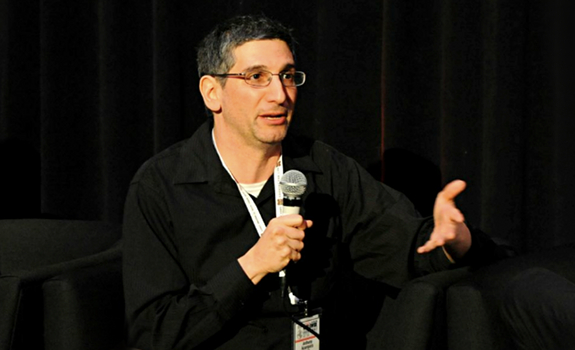
RadioCrunch partner Anthony Acampora has learned that overall successful syndicated shows or hit songs not necessarily work everywhere, as audience preferences can be significantly different locally (photo: KC Morse)
Track long-term market developments
Researcher Anthony Acampora thinks that PPM data give a pretty good overview of what happens in a radio market over a long period of time – making clear that PDs should never take decisions based on short-term data, like weekly reports based on incidents. Shocking news about the Boston Marathon bombings or social events like a Memorial Day weekend create temporary changes in listening behavior. “You can’t drive yourself crazy looking at those things. What you can do, is look at your station over a long period of time.” Between the start of 2012 and the middle of 2013, he’s noticed a significant growth of the Hispanic population in many American radio markets. “That’s the future of the population in this country and radio listening.”
 Find market-specific (music) data
Find market-specific (music) data
Acampora makes an important point about syndicated programming across the US. “One thing I’ve learned from doing different markets with all different backgrounds is: it is not a ‘one size fits all’ business. Every market is unique.” He’s learned that within the United States, music tastes can be very different locally. “If you look at the granular level of it, you will see songs that can be #1 hits in America and they won’t work in a [specific] market.”
Keep playing songs longer
The researcher is noticing a growing number of copycats. “The biggest trend we’re seeing, is: hey – this is the number 1 radio station in the market. I’m going to put on another one that competes with them, play every single thing that they do, and chop them down. We’ve seen a lot of heritage radio stations defend themselves very well.” He’s more concerned about the declining variety (as some markets have up to 3 Country or Top 40 stations) while the Alternative format, which breaks new music, disappeared from many markets. But those that still exist, have often learned their lessons – like don’t immediately drop CHR crossovers from the Alternative playlist once they become hits. “Before, if The Lumineers had crossed Top 40, Alternative would stop playing the record.” Other good news is that in the first quarter of 2013, radio has broken more new artists than during the same period of the last 10 years.
“You have to know when to color outside the lines”
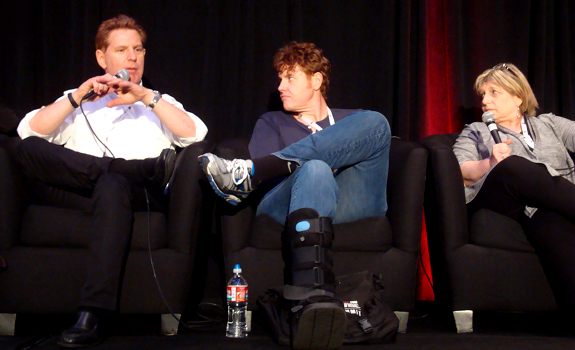
Power 106 Los Angeles program director and Emmis Communications group PD Jimmy Steal (sitting on the left) underlines the importance of knowing when it’s time to refresh your format and brand (photo: Thomas Giger)
Be consistently positively different
Session host Mike McVay quotes radio manager Val Maki who once said that “the station that does the most things right over the longest period of time, usually ends up doing very well in the ratings.” He also believes in offering something different. “What are you delivering to people that they can’t get elsewhere? What are you doing to impact their behavior to consume your product across all platforms? (…) In the hallways of Cumulus Corporate in Atlanta, on all program directors’ doors we have a picture of a sign that says: program the hell out of it”, McVay says about their goal to create the best listening experience. They want that “the music is spot on; air talents are connected; imaging fits the market; promotions and marketing all come together.”
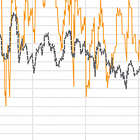 Utilize long-term PPM insights
Utilize long-term PPM insights
Philippe Generali sees PPM as a source of insights (e.g. the average radio listening occasion is 10 minutes) and content testing (e.g. finding out whether that Phone Tap every day at 8:30 works or doesn’t work in the long run). PPM even helps to take some calculated risks. That 1-hour celebrity interview might kill your PPM ratings for the next hour(s), but can really lift your brand’s image: “Thanks to the meter, I know how much I have to pay for that.”
Keep re-inventing your format
Program director Jimmy Steal believes in going against radio rules now and then. “You can build a perfect radio station on paper, and it can be as exciting as watching paint dry – so you have to know when to color outside the lines.” Power 106 has an afternoon show called New@2 where they play nothing but new music for an entire hour. “It was generally perceived as insane. Why would you do that in the middle of the day?” Steal feels like that’s changed since ‘music discovery’ has become a buzz phrase and led to discovering YouTube stars like Becky G who now has a record deal. “The research is all great, but if you can’t build something that’s exciting and experiential to the people who are consuming your product, then you can have all the research in the world and you’re so screwed.”
“The fact that losing a big meter
can have an impact is a problem”
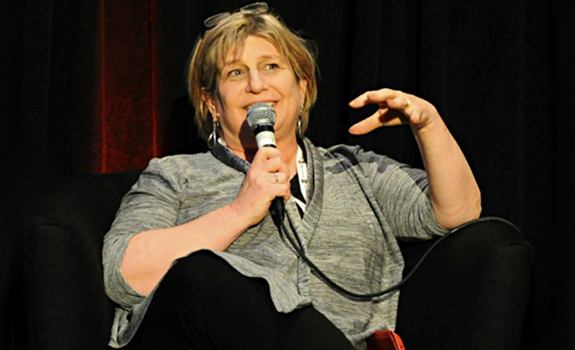
Audience researcher Carolyn Gilbert of nuvoodoo sees that when a station’s broadcast area includes a relatively small number of Portable People Meter carriers, it can seriously affect that station’s PPM ratings (photo: KC Morse)
Hire proactive radio personalities
John Michael knows that “the things that sometimes make your station interesting and compelling to people are in direct conflict with what we know that PPM methodology is.” He sees it as the art of radio programming to judge that a great promo (which is theoretically too long) can run anyway. “The trick is just to know when you can take those shots.” The same goes for selecting the on-air staff – instead of sterile and antiseptic people, he rather hires smart and creative talents that need to be pulled back for doing too much. Jimmy Steal’s vision of the near future of radio is one of real-time entertainment – pushing compelling content 24/7 to multiple platforms, including live video. “Your best defense is to have the best people you can possibly have around you, and let them do what they do best. Because if you don’t put passion in, you don’t get passion out.”
 Beware of sample shifting
Beware of sample shifting
“Don’t follow it off the cliff”, Anthony Acampora warns PDs and GMs to don’t jump the conclusions based on sudden changes in ratings. The sample size in a certain area could be down or it’s because the station has a weaker signal. “If you don’t have a full coverage in a market, you can see wobbles even more – just based on where the sample moves.” Carolyn Gilbert: “The fact that losing a big meter can have an impact is a problem”.
Research radio survey participants
But she feels like Arbitron are doing the best they can, and knows that research isn’t cheap. Jimmy Steal hopes that Nielsen’s purchase of Arbitron leads to a larger sample size. Philippe Generali provides more perspective by mentioning that the $15 billion dollar radio market in the United States [BIA/Kelsey estimate for 2013] has its ratings based on a panel of around 70.000 people nationwide, while the much larger, $70 billion dollar TV industry is measured by a panel of only 20.000 people for the whole US. Continuing on the profile of participants that carry a meter, Carolyn Gilbert has a positive note. Research shows that these people love radio. “They’re passionate about their stations; they’re more likely to engage socially; they like contests; they read their direct mail. We can reach them and convert them much more easily. This is the really good news that we should optimize in marketing.”
“Over a 12-second intro
they keep giving you an amazing story”
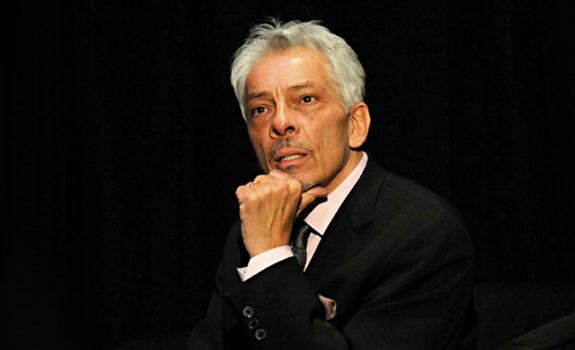
Former radio consultant and current group programmer for Cumulus Media, Mike McVay, says that most Boss Radio format standards (set by Bill Drake and Lester Chenault) still apply to today’s radio (photo: KC Morse)
Minimize number of breaks
What are the top 3 takeaways for PDs in any market, based on what you’ve learned from PPM? was my question for the panel of researchers and programmers. Jimmy Steal takes it first:
1. “Have as few commercial breaks as you can. I would not recommend more breaks that are shorter – if you could stop only twice an hour, I would do that.”
2. “I would make sure that jocks are really tutored well in communicating high-value things in a very short period of time. I would make everything passive relevancy filtered.”
3. “Ask [listeners] what they want to win, and make sure you give them things they can’t just buy off the shelf at a store.”
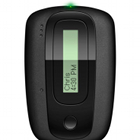 Market towards PPM carriers
Market towards PPM carriers
John Michael feels like there actually haven’t been many changes since the introduction of PPM except for where and where not to position stop sets. “The things you hear – in a PPM world, you’ve got to do X, Y, Z – you should be doing anyway.” Carolyn Gilbert thinks that marketing has become even more important. “We market a little differently for PPM than for diary, because you’re not looking for top of mind recall anymore.”
Say more in less time
Anthony Acampora shares a personal story: “I didn’t grow up in the Boss Radio era, but kind of after. My thing was KIIS-FM in the 80s here in Los Angeles, which to me just had the Boss Radio elements. If Bill was with us today and you look at the best PPM fundamentals… him and his folks back in the 60s were doing those. I don’t think they changed; they’re more relevant today than they might have been back then.” Mike McVay rounds up the answer to my question by explaining why he does prefer efficiency (rather than brevity) of on-air talents during air check meetings. “If it takes you a minute to tell me a compelling story and you can’t do it in less, then that’s okay. But if you could have done it in 20 seconds, you weren’t efficient. I use the examples of The Real Don Steele, Robert W. Morgan, Charlie Tuna and those guys, because over a 12-second intro they keep giving you an amazing story.”
 Combine radio’s art & science
Combine radio’s art & science
Jimmy Steal advocates that even in LA were stakes are pretty high, you shouldn’t (and he doesn’t) always play it safe when it comes to programming. “If you live in a market where a tenth of a rating point is a few million dollars in billing – very high risk, very high reward. (…) Great radio is a balance of art and science. Because I was a jock for a long time, I personally default a little more on the art side, but never loose sight of the science.”





Add Your Comment